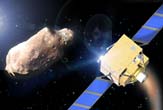A cluster of several satellites observing the asteroids may one day be able to save the Earth from space rocks crossing the Earth's orbit.
Avi Blizovsky

Direct link to this page: https://www.hayadan.org.il/simone290503.html
Researchers working for the European Space Agency (ESA) are developing plans to send a fleet of five spacecraft to nearby asteroids and other objects to learn more about their size, shape and orbit in our planetary environment. They hope to develop a better understanding of these neighboring rocks and prepare for the danger of one of them making its way straight to us.
The operation is designed to prepare and identify in advance any danger of a future collision, said the project's scientific director Simon Green. Green is a researcher at the Institute of Planetary and Space Sciences at the Open University of Great Britain, a partner in the Kinetic QinetiQ technology group within SIMONE. "We must learn as much as possible about objects close to the earth in order to identify one that may harm."
SIMONE - an acronym for Smallsat Intercept Missions to Objects Near Earth is one of six low-cost missions under development at the European Space Agency and which are designed to study space rocks.
With the help of SIMONE, the scientists plan to launch five microsatellites, each of which will fly to a different asteroid. The spaceships, in the shape of a cube, will measure 3 meters on each side and weigh 120 kg.
When they reach space, each of them will detach a pair of wings containing solar collectors to generate the electricity needed to drive the ion engine, a propulsion system that uses charged particles to propel the spacecraft through space. NASA used such a drive in the Deep Space 1 spacecraft.
"This technology has been with us for a while," said Andre Geeves, head of the European Space Agency's Advanced Propulsion Team, and he means the ion engine. "But Simona will be the first spacecraft for such a small satellite to use such a propellant."
"Each Simona spacecraft will be independent," said Green, "with a budget where it was customary to send one spacecraft so far, we get five."
It is estimated that the cost of the project will be 160 million euros. The budget includes equipping each such spacecraft with a multispectral camera for photography and an X-ray spectrometer to determine the composition of the asteroid, scientific equipment to test the mass of the asteroids by radio, an infrared spectrometer to search for minerals and other details on the surface, and a laser altimeter to make topographical measurements.
For news on Yahoo's news site
They knew cosmic collisions
https://www.hayadan.org.il/BuildaGate4/general2/data_card.php?Cat=~~~542265479~~~35&SiteName=hayadan
